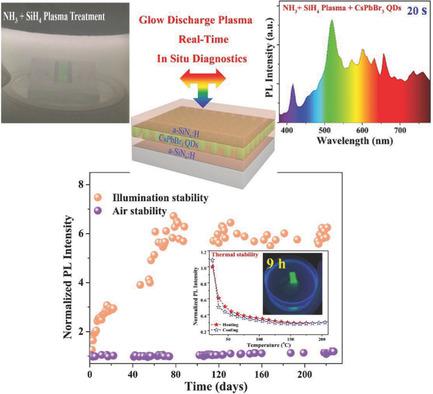当前位置:
X-MOL 学术
›
Adv. Funct. Mater.
›
论文详情
Our official English website, www.x-mol.net, welcomes your
feedback! (Note: you will need to create a separate account there.)
Highly Luminescent and Stable Si‐Based CsPbBr3 Quantum Dot Thin Films Prepared by Glow Discharge Plasma with Real‐Time and In Situ Diagnosis
Advanced Functional Materials ( IF 18.5 ) Pub Date : 2018-10-16 , DOI: 10.1002/adfm.201805214 Zhenxu Lin 1 , Rui Huang 1 , Wenxing Zhang 1 , Yi Zhang 1 , Jie Song 1 , Hongliang Li 1 , Dejian Hou 1 , Yanqing Guo 1 , Chao Song 1 , Neng Wan 2 , Paul K. Chu 3
Advanced Functional Materials ( IF 18.5 ) Pub Date : 2018-10-16 , DOI: 10.1002/adfm.201805214 Zhenxu Lin 1 , Rui Huang 1 , Wenxing Zhang 1 , Yi Zhang 1 , Jie Song 1 , Hongliang Li 1 , Dejian Hou 1 , Yanqing Guo 1 , Chao Song 1 , Neng Wan 2 , Paul K. Chu 3
Affiliation

|
Although all‐inorganic perovskite quantum dots (QDs) have outstanding optoelectronic properties, they tend to have poor stability in air and water, at high temperatures, and under light irradiation. Herein, a glow discharge plasma process incorporating real‐time and in situ diagnosis is designed for efficient encapsulation to improve the stability of CsPbBr3 QD films. An ammonia/silane plasma which has less destructive effects on CsPbBr3 QDs is used in plasma‐enhanced chemical vapor deposition to produce a‐SiNx:H on the CsPbBr3 QDs. The a‐SiNx:H encapsulating layers endow CsPbBr3 QDs with long‐term stability during exposure to air, at a high temperature (205 °C), and in water. In contrast to severe degradation of pure CsPbBr3 QDs under UV illumination, the CsPbBr3 QDs/a‐SiNx:H films show more than 5‐folds increase in photoluminescence intensity after UV illumination for 80 d and long‐term stability is observed after UV illumination for 140 d. The plasma treatment not only stabilizes CsPbBr3 QDs, but enhances photoluminescence efficiency by combining with illumination as well. The nanocomposite films assembled into commercial InGaN chips feature strong cold white emission. Our results reveal a practical way to design and fabricate highly luminescent as well as stable Si‐based CsPbBr3 QD films for future development of optoelectronic devices.
中文翻译:

辉光放电等离子体制备的高发光且稳定的基于Si的CsPbBr3量子点薄膜,具有实时和原位诊断功能
尽管全无机钙钛矿量子点(QD)具有出色的光电性能,但它们在空气和水中,高温和光照下的稳定性往往较差。本文中,结合实时和原位诊断的辉光放电等离子体工艺旨在进行有效封装,从而提高CsPbBr 3 QD薄膜的稳定性。这对CsPbBr较少破坏作用的氨/硅烷等离子体3的QD是在等离子体增强型化学气相沉积中使用,以产生型SiN X:H在CsPbBr 3的QD。a-SiN x:H封装层赋予CsPbBr 3QD在暴露于空气,高温(205°C)和水中期间具有长期稳定性。与纯CsPbBr 3 QD在UV照射下严重降解相反,CsPbBr 3 QDs / a-SiN x:H膜在UV照射80 d后显示的光致发光强度增加了5倍以上,并且观察到长期稳定性紫外线照射140 d。等离子体处理不仅可以稳定CsPbBr 3 QD,而且还可以通过结合照明来提高光致发光效率。组装到商用InGaN芯片中的纳米复合薄膜具有强烈的冷白光发射特性。我们的结果揭示了一种设计和制造高发光以及稳定的基于Si的CsPbBr 3的实用方法。 用于光电设备未来发展的QD胶片。
更新日期:2018-10-16
中文翻译:

辉光放电等离子体制备的高发光且稳定的基于Si的CsPbBr3量子点薄膜,具有实时和原位诊断功能
尽管全无机钙钛矿量子点(QD)具有出色的光电性能,但它们在空气和水中,高温和光照下的稳定性往往较差。本文中,结合实时和原位诊断的辉光放电等离子体工艺旨在进行有效封装,从而提高CsPbBr 3 QD薄膜的稳定性。这对CsPbBr较少破坏作用的氨/硅烷等离子体3的QD是在等离子体增强型化学气相沉积中使用,以产生型SiN X:H在CsPbBr 3的QD。a-SiN x:H封装层赋予CsPbBr 3QD在暴露于空气,高温(205°C)和水中期间具有长期稳定性。与纯CsPbBr 3 QD在UV照射下严重降解相反,CsPbBr 3 QDs / a-SiN x:H膜在UV照射80 d后显示的光致发光强度增加了5倍以上,并且观察到长期稳定性紫外线照射140 d。等离子体处理不仅可以稳定CsPbBr 3 QD,而且还可以通过结合照明来提高光致发光效率。组装到商用InGaN芯片中的纳米复合薄膜具有强烈的冷白光发射特性。我们的结果揭示了一种设计和制造高发光以及稳定的基于Si的CsPbBr 3的实用方法。 用于光电设备未来发展的QD胶片。











































 京公网安备 11010802027423号
京公网安备 11010802027423号